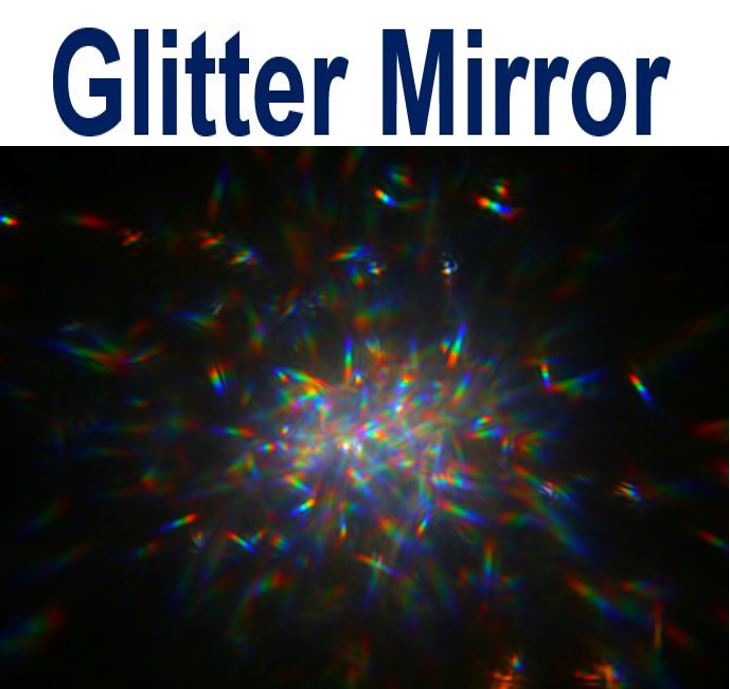Using glitter clouds instead of mirrors for stargazing telescopes would be much cheaper and make for easier-to-deploy orbiting instruments, NASA says. Telescopes could have reflective glitter-like particles that act as mirrors within them.
According to scientists at the Jet Propulsion Laboratory (JPL) in Pasadena, California, using glitter clouds would enable high-resolution imaging at considerably lower costs, without the need to set up costly and bulky mirrors.
Conventional telescopes use solid mirrors to image exoplanets (planets beyond our solar system) and stars. However, the big, complex mirrors needed to look into deep space are costly and difficult to build. Their huge size and weight add to the challenges of launching an orbiting telescope in the first place.

Image shows white light reflected off of a glitter mirror onto a camera sensor. Scientists tested this in the lab as part of the concept of ‘Orbiting Rainbows’. (Credit: G. Swartzlander/Rochester Institute of Technology)
Researchers considering Orbiting Rainbows
Scientists at JPL wondered whether Orbiting Rainbows might make it easier and cheaper to deploy orbiting telescopes. They would like to use clouds of reflective glitter-like particles to replace solid mirrors to help telescopes capture images of deep space.
With Orbiting Rainbows you would still get high-resolution images, but at signficiantly lower costs, they say.
JPL Orbiting Rainbow’s lead researcher, Marco Quadrelli, explained:
“It’s a floating cloud that acts as a mirror. There is no backing structure, no steel around it, no hinges; just a cloud.”
Glitter clouds shaped by laser beams
JPL scientists say that multiple laser beams would be able to trap and manipulate the glitter-like particles in a small cloud.
With the momentum of the laser light photons (tiny light particles) coming from two directions, the glitter particles would be trapped – one set of photons would push them away, while another would push them toward the axis of the light beam.
The laser beams would come from several different directions, applying pressure from various points and shaping the mirror cloud, pushing the small particles to align in the same direction.
The cloud in the space telescope would contain millions of grains, each one less than a millimeter in diameter.
For the telescope to work properly, it would need a wide adjustable aperture, the space through which light passes during an optical or photographic measurement.

Rochester Institute of Technology researchers made a mirror surface out of glitter to try out the idea of using a cloud of reflective particles as a space telescope mirror. They took images of two light sources using this mirror in the lab. (Credit: G. Swartzlander/Rochester Institute of Technology)
More nimble telescopes
Without the bulky mirror, telescopes made for an Orbiting Rainbows system would be much easier and simpler to package, transport and send into orbit compared to conventional ones.
Quadrelli said “You deploy the cloud, trap it and shape it.”
Nature (on Earth and in space) has many structures with light-scattering and focusing features, such as comet trails and rainbows.
Observing these natural phenomena, as well as successful lab experiments in optical trapping and manipulation, have contributed to the idea of using Orbiting Rainbows technology.
Antoine Émile Henry Labeyrie, a French astronomer who worked at the College de France in Paris, first proposed using a telescope based on a laser-trapped mirror in a 1979 paper.
JPL scientists are currently trying to identify ways to manipulate and maintain the shape of an orbiting cloud of dust-like particles using laser pressure so it can function as a reflective, adaptive surface with useful electromagnetic characteristics, for example, in the optical or radar bands.
More distortions with glitter cloud
A glitter cloud does not have a smooth surface, so the image created from those particles in a telescope would be ‘noisier’ – there would be more speckled distortion – than what one would get with a conventional mirror.
The researchers are creating algorithms to take multiple images and computationally remove the speckle effect from the glitter.
Co-researcher Gover Swartzlander, an associate professor at the Rochester Institute of Technology, New York, and some of his students spread glitter on a concave lens in the laboratory to test the idea.
They used laser beams to represent light from a two-star (binary star) system. The speckled mirror was pointed at the binary star simulation, and a camera was used to capture pictures. After a number of exposures and a great deal of processing, the image of the two ‘stars’ appeared using the glitter mirror.
Regarding their feat, Quadrelli said:
“This is a major achievement. This demonstrates a highly controlled experiment in which we were able to do imaging in the visible light spectrum.”
Visible light versus radio-band signals
It is easier to use the technology for radio-band signals. Radio-band signals are much longer (1 centimeter) than visible light (nanometers), so the mirror grains would not have to be as carefully aligned or controlled.
This opens up applications for a number of Earth science possibilities, including remote sensing of water, earthquake detection and other phenomena.
JPL scientist Darmindra Arumugam is researching potential mechanisms for remote sensing with Orbiting Rainbows.
JPL’s optical design researchers have been working on the adaptive optics techniques that would be needed by a telescope using Orbiting Rainbows technology. They have been exploring reflective and diffractive versions of a telescope based on Orbiting Rainbows, with maximum sensitivity at a specific frequency.
In order to demonstrate that Orbiting Rainbows technology in low-Earth orbit is viable, the researchers must deploy a telescope with a small patch of particles, no larger than a bottle cap, to show that it can be manipulated and shaped to reflect light.
According to NASA “The next step would be to make many of these patches and synthesize an aperture with which to do imaging.”
JPL Video – Orbiting Rainbows
This JPL video explains the Orbiting Rainbows concept.
